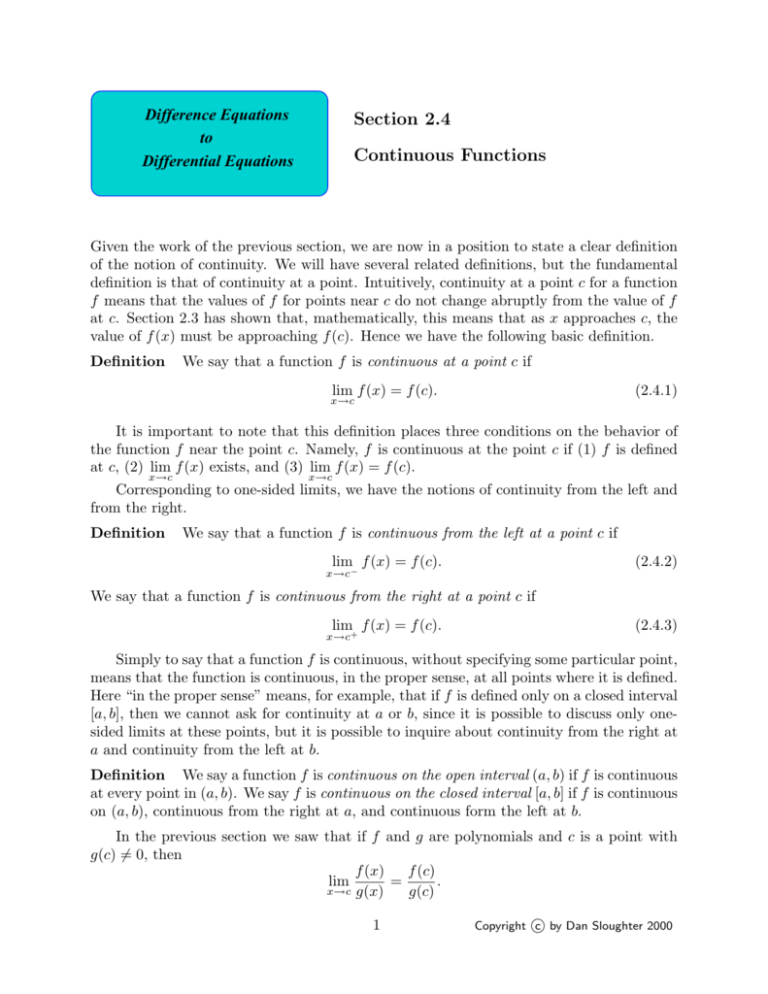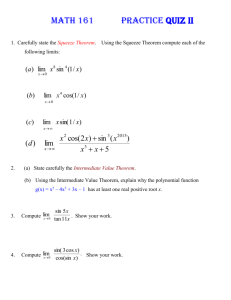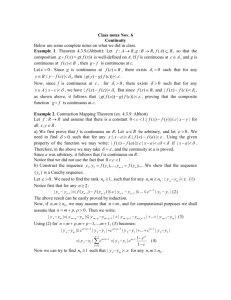Section 2.4 Continuous Functions
advertisement

Difference Equations
to
Differential Equations
Section 2.4
Continuous Functions
Given the work of the previous section, we are now in a position to state a clear definition
of the notion of continuity. We will have several related definitions, but the fundamental
definition is that of continuity at a point. Intuitively, continuity at a point c for a function
f means that the values of f for points near c do not change abruptly from the value of f
at c. Section 2.3 has shown that, mathematically, this means that as x approaches c, the
value of f (x) must be approaching f (c). Hence we have the following basic definition.
Definition
We say that a function f is continuous at a point c if
lim f (x) = f (c).
(2.4.1)
x→c
It is important to note that this definition places three conditions on the behavior of
the function f near the point c. Namely, f is continuous at the point c if (1) f is defined
at c, (2) lim f (x) exists, and (3) lim f (x) = f (c).
x→c
x→c
Corresponding to one-sided limits, we have the notions of continuity from the left and
from the right.
Definition
We say that a function f is continuous from the left at a point c if
lim f (x) = f (c).
(2.4.2)
x→c−
We say that a function f is continuous from the right at a point c if
lim f (x) = f (c).
x→c+
(2.4.3)
Simply to say that a function f is continuous, without specifying some particular point,
means that the function is continuous, in the proper sense, at all points where it is defined.
Here “in the proper sense” means, for example, that if f is defined only on a closed interval
[a, b], then we cannot ask for continuity at a or b, since it is possible to discuss only onesided limits at these points, but it is possible to inquire about continuity from the right at
a and continuity from the left at b.
Definition We say a function f is continuous on the open interval (a, b) if f is continuous
at every point in (a, b). We say f is continuous on the closed interval [a, b] if f is continuous
on (a, b), continuous from the right at a, and continuous form the left at b.
In the previous section we saw that if f and g are polynomials and c is a point with
g(c) 6= 0, then
f (x)
f (c)
lim
=
.
x→c g(x)
g(c)
1
c by Dan Sloughter 2000
Copyright 2
Continuous Functions
Section 2.4
The following proposition restates this fact in terms of our new definitions.
Proposition If h is a rational function and h is defined at the point c, then h is continuous at c. In particular, if h is a polynomial, then h is continuous on the entire real line
(−∞, ∞).
This theorem gives us a very large class of functions which we know to be continuous.
As we progress, we will add many more types of functions to this class.
Example Consider the function f (x) = 3x3 − 6x + 3. Since f is a polynomial, it is
continuous on (−∞, ∞). That is, for any real number c, f is continuous at c.
Example
Consider
g(t) =
8t − 13t2
.
3t − 4
Then g is a rational function, and so is continuous at all points in its domain. That is, g
is continuous for all real numbers c except c = 34 . Put another way, g is continuous on the
intervals (−∞, 43 ) and ( 43 , ∞).
Example
Suppose
h(z) =
z 2 − 2, if z ≤ 1,
4z − 2, if z > 1.
On the interval (−∞, 1], h is a polynomial; thus h is continuous on (−∞, 1]. Note that
this does not necessarily mean that h is continuous at 1, only that h is continuous from
the left at 1. Similarly, on the interval (1, ∞), h is a polynomial and hence is continuous
on (1, ∞). To check for continuity at 1, we note that
lim h(z) = lim− (z 2 − 2) = −1,
z→1−
z→1
while
lim h(z) = lim (4z − 2) = 2.
z→1+
z→1+
Since these limits are different, we know that lim h(z) does not exist. Thus h is not
z→1
continuous at 1. As we saw in Section 2.3, this behavior results in a break in the graph of
h at z = 1. See Figure 2.4.1.
Example
Suppose
f (s) =
s + 1, if s < 0,
s2 + 1, if s ≥ 0.
Similar to the situation in the previous example, f is continuous on the intervals (−∞, 1)
and [1, ∞) since it is a polynomial on both of these intervals. Now
lim f (s) = lim− (s + 1) = 1
s→0−
s→0
and
lim f (s) = lim (s2 + 1) = 1.
s→0+
s→0+
Section 2.4
Continuous Functions
3
12
10
8
6
4
2
-2
1
-1
2
3
4
2
3
-2
Figure 2.4.1 Graph of y = h(z)
10
8
6
4
2
-3
-2
1
-1
-2
Figure 2.4.2 Graph of y = f (s)
Thus lim f (s) = 1; since f (0) = 1, we have
s→0
lim f (s) = 1 = f (0).
s→0
Thus f is continuous at 1. Altogether this shows that f is continuous on the entire interval
(−∞, ∞). As we see in Figure 2.4.2, the graph of f does not have a break at s = 0.
Example
Suppose
2
x − 4 , if x 6= 2,
x−2
g(x) =
6,
if x = 2.
Then, since g is a rational function on the intervals (−∞, 2) and (2, ∞), and is defined
throughout these intervals, g is continuous on the intervals (−∞, 2) and (2, ∞). To check
4
Continuous Functions
Section 2.4
8
6
4
2
1
-1
2
3
4
5
Figure 2.4.3 Graph of y = g(x)
for continuity at 2, we notice that
x2 − 4
(x − 2)(x + 2)
= lim
= lim (x + 2) = 4,
x→2 x − 2
x→2
x→2
x−2
lim g(x) = lim
x→2
while g(2) = 6. Hence lim g(x) 6= g(2), and so g is not continuous at 2. See Figure 2.4.3.
x→2
It is interesting to note that in the last example the function g could be made continuous
if its value at 2 were changed from 6 to 4. In general, if, for a function f and a point c,
lim f (x) = L, but f is not continuous at c because either f is not defined at c or f (c) 6= L,
x→c
we can define a new function h such that h(x) = f (x) for all x 6= c and h is continuous at
c. Namely, if we let
f (x), if x 6= c,
h(x) =
L,
if x = c,
then h(x) = f (x) for all x 6= c and
lim h(x) = lim f (x) = L = h(c).
x→c
x→c
Thus h is a function which is identical to f everywhere except at c, but, unlike f , is
continuous at c. In this case we say that f has a removable discontinuity at c. Note that
the existence of a limit at c is essential in order for a discontinuity at c to be removable.
The following proposition lists some properties of continuous functions, all of which
are consequences of our results about limits in Section 2.3.
Proposition Suppose the functions f and g are both continuous at a point c and k is a
constant. Then the functions which take on the following values for a variable x are also
continuous at c:
kf (x),
(2.4.4)
Section 2.4
Continuous Functions
5
f (x) + g(x),
(2.4.5)
f (x) − g(x),
(2.4.6)
f (x)g(x),
(2.4.7)
f (x)
,
g(x)
(2.4.8)
(f (x))p ,
(2.4.9)
provided g(c) 6= 0, and
provided p is a rational number and (f (x))p is defined on an open interval containing c.
Example It follows from (2.4.9) that functions of the form f (x) = xp , where p√ is a
rational number, are continuous throughout their domain. For example, f (x) = x is
continuous on [0, ∞).
Example
Using (2.4.8) and (2.4.9),
√
g(t) =
3t + 2
2t
is continuous for all points t where 3t + 2 ≥ 0 and t 6= 0. Thus g is continuous on the
intervals [− 23 , 0) and (0, ∞).
At this point we have the tools necessary to determine questions of continuity for
algebraic functions. We will now show that the sine and cosine functions are continuous
on (−∞, ∞). For 0 < x < π2 , consider the point C = (cos(x), sin(x)) on the unit circle
centered at the origin. If we let A = (0, 0) and B = (1, 0), as in Figure 2.4.4, then the area
of 4ABC is
1
sin(x).
2
The area of the sector of the circle cut off by the arc from B to C is the fraction
area of the entire circle; hence, this area is
x
x
π= .
2π
2
Since this sector contains 4ABC, we have
0<
1
x
sin(x) < ,
2
2
from which it follows that
0 < sin(x) < x.
Since
lim x = 0,
x→0+
x
2π
of the
6
Continuous Functions
Section 2.4
(0, 1)
C
sin( x)
x
B
A
(1, 0)
Figure 2.4.4
it follows that
lim sin(x) = 0.
x→0+
Moreover, we also have
lim sin(x) = lim sin(−x) = − lim sin(x) = 0,
x→0−
x→0+
x→0+
so
lim sin(x) = 0.
(2.4.10)
x→0
Since sin(0) = 0, this shows that sine is continuous at 0. Now for − π2 < x <
cos(x) =
π
2,
q
1 − sin2 (x).
Hence
q
q
lim cos(x) = lim 1 − sin2 (x) = 1 − lim sin2 (x) = 1.
x→0
x→0
x→0
(2.4.11)
Since cos(0) = 1, this shows that cosine is continuous at 0. For an arbitrary c, we have,
using the angle addition formulas for sine and cosine,
lim sin(x) = lim sin(c + h)
x→c
h→0
= lim (sin(c) cos(h) + cos(c) sin(h))
h→0
= sin(c) lim cos(h) + cos(c) lim sin(h)
h→0
= sin(c)(1) + cos(c)(0)
= sin(c)
h→0
Section 2.4
Continuous Functions
7
and
lim cos(x) = lim cos(c + h)
x→c
h→0
= lim (cos(c) cos(h) − sin(c) sin(h))
h→0
= cos(c) lim cos(h) − sin(c) lim sin(h) .
h→0
h→0
= cos(c)(1) − sin(c)(0)
= cos(c)
Thus we have the following proposition.
Proposition
The sine and cosine functions are continuous on (−∞, ∞).
The next proposition is then an immediate consequence of (2.4.8).
Proposition The tangent, cotangent, secant and cosecant functions are continuous at
all points in their respective domains.
We have not yet considered the composition of continuous functions. Suppose g is
continuous at c and f is continuous at g(c). If {xn } is a sequence converging to c, then
we know, since g is continuous at c, that the sequence {g(xn )} will converge to g(c). But
then, since f is continuous at g(c), the sequence {f (g(xn ))} will converge to f (g(c)). That
is,
lim f ◦ g(x) = lim f (g(x)) = f (g(c)) = f ◦ g(c).
(2.4.12)
x→c
x→c
Hence f ◦ g is continuous at c.
Proposition
at c.
If g is continuous at c and f is continuous at g(c), then f ◦ g is continuous
Example The function h(t) = cos(3t + 4) is continuous on (−∞, ∞) since it is the
composition of the functions g(t) = 3t + 4 and f (t) = cos(t), both of which are continuous
on (−∞, ∞).
Example
Consider the function
g(t) =
sin(t2 + 1)
.
t
Now the numerator of g is continuous on (−∞, ∞) since it is the composition of h(t) = t2 +1
and f (t) = sin(t), both of which are continuous on (−∞, ∞). It follows that, since the
denominator of g is continuous on (−∞, ∞), g is continuous at all points for which the
denominator is not equal to zero, that is, for all t 6= 0. Thus g is continuous on the intervals
(−∞, 0) and (0, ∞).
In Section 2.5 we will consider two properties of continuous functions which partially
explain the important role they play in calculus.
8
Continuous Functions
Section 2.4
Problems
1. Discuss the continuity of the given function at the specified point.
2x + 5
(a) f (t) = 3t2 − 6 at t = 2
(b) f (x) =
at x = 17
x − 16
2x + 5
s2 − 1
(c) f (x) =
at x = 16
(d) h(s) =
at s = 1
x − 16
s+1
s2 − 1
(e) h(s) =
at s = −1
s+1
2. Discuss the continuity of the function
4t − 1, if t ≤ 2,
g(t) =
t + 5, if t > 2,
at t = 2.
3. Discuss the continuity of the following functions.
t2 − t − 6
t+2
8
(d) f (u) = 2
u −4
1
(f) g(x) = √
9 − x2
(a) g(x) = 4x23 − x18 + 16x − 3
(b) f (t) =
8
(c) g(t) = 32t −
t
p
(e) f (t) = t2 − 4
4. Discuss the continuity of the function
3x + 2, if x < 1,
f (x) =
3x + 1, if x ≥ 1.
5. Discuss the continuity of the function
z 2 − 1, if z ≤ −1,
h(z) =
z − 1, if z > −1.
6. The function
t2 − 7t + 12
t−4
is not continuous at t = 4. Is this discontinuity removable? If it is, define a new
function g which agrees with f whenever t 6= 4, but is continuous at 4.
f (t) =
7. The function
t2 − 7t + 12
f (t) =
t−5
is not continuous at t = 5. Is this discontinuity removable? If it is, define a new
function g which agrees with f whenever t 6= 5, but is continuous at 5.
Section 2.4
Continuous Functions
8. Explain why g(x) = x2 sin(x2 + 1) is continuous on (−∞, ∞).
9. Recall that the Heaviside function is defined by
H(t) =
0, if t < 0,
1, if t ≥ 0.
(a) Discuss the continuity of f (t) = H(t2 + 1). Graph f on the interval [−5, 5].
(b) Discuss the continuity of g(t) = H(t2 − 1). Graph g on the interval [−5, 5].
(c) Discuss the continuity of h(t) = H(sin(πt)). Graph h on the interval [−5, 5].
10. Discuss the continuity of f (x) = bxc and g(x) = dxe.
11. Discuss the continuity of f (x) = bsin(x)c and g(x) = dsin(x)e.
9





